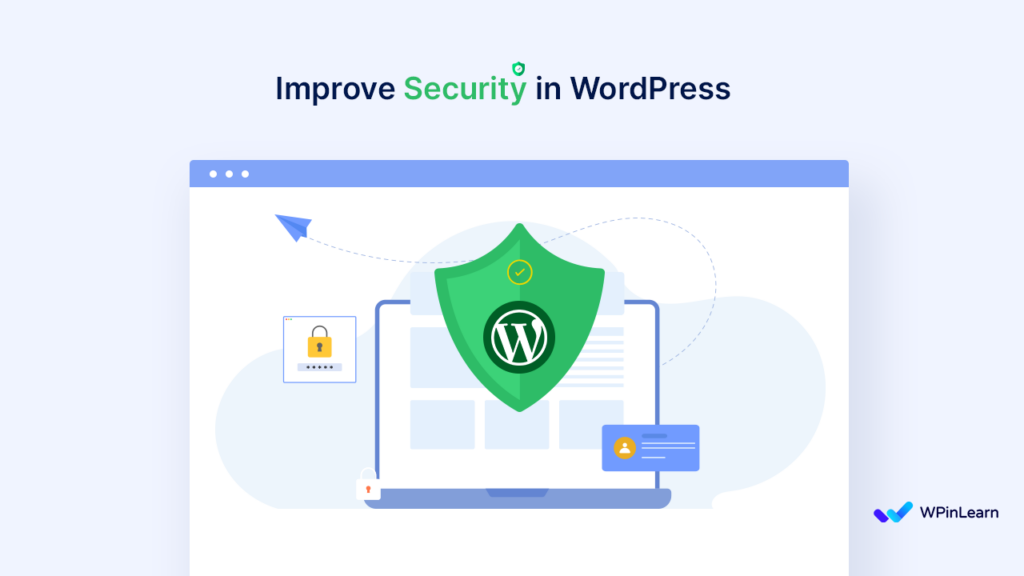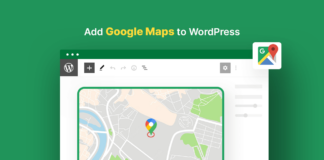Are you concerned about how to Improve Security in WordPress? If so, we will help you improve your WordPress website’s security. We’ll also talk about a few plugins that might aid in the security of your WordPress website. Learn more by reading on.

Table of Contents
Importance Of Learning WordPress Security For Beginners
If you are a beginner looking to learn WordPress, then you need to know how to improve security in WordPress 2023. WordPress can be an excellent tool for building almost any website. As it is so simple to use, even a beginner can create a fully functioning website in no time.
However, it is important to know that your WordPress website can be a target for hackers. Although it is not difficult to learn WordPress security, beginners should prioritize it. To do it correctly, all it needs is a little time and effort.
This means that, as a beginner, you should learn how to improve security in WordPress 2023. If you know about WordPress security for beginners, you can improve security in WordPress and create a very secure website.
Hackers all have the same objective: accessing a website and using it for their own personal gain. They have a variety of options. Nevertheless, they frequently exploit weaknesses in the WordPress program.

Types of WordPress Hacking Attacks
Many people aren’t aware of WordPress breaches, but it’s important to know about them in order to safeguard your website in advance.
There are many ways to hack a WordPress website.
In order to help you improve security in WordPress, let’s examine some of the most common methods of website security and what to anticipate in terms of potential abuse.
- Malware
Malware is a catch-all word for malicious software that exploits a website’s flaws for a variety of negative purposes. Malware in WordPress may impact a website’s performance on every level, including the web server, the user experience, and even the site’s SEO performance, when it comes to WordPress websites.
- SQL Injection
A form of attack known as SQL injection, or SQLi, allows an attacker to input malicious SQL queries into a web application with the ability to access or delete sensitive database data from the WordPress website.
- Backdoors
A WordPress backdoor is a code that gives an attacker persistent, unauthorized access to the server. Frequently, a harmful file is concealed elsewhere. Or occasionally, it can be a malicious plugin. Every month, new variations of WordPress backdoor hacks are discovered.
- Malicious Redirects
A type of attack known as “WordPress Malware Redirect” or “WordPress Redirect Hack” involves an infected website redirecting users to malware, phishing, and harmful websites. Your WordPress site may be redirected to another website as a result of the code that has been injected into your WordPress database.
- Cross-Site Scripting (XSS)
Introducing malicious JavaScript code into a website is known as a cross-site scripting attack or WordPress XSS. The code is run by the visitor’s browser when they access that website. It is presumed that the malicious script came from a reliable source, in this case, the website.
- DDoS Attack
The term “DDoS attack” refers to a particular kind of cyberattack that takes advantage of hacked hardware to transmit or request data from a WordPress hosting server. These queries are sent with the intention of slowing down the targeted server and ultimately crashing it.
A handful of the most common brute force attacks that target WordPress websites are listed above.
Based on all this information, you may realize that security is very important from the beginning of creating a website.
WordPress Security Checklist: Things To Consider About WordPress Security
WordPress sites are not always attacked by hackers. They only target WordPress sites that are weak and easy to compromise. By carefully following the instructions in the following WordPress Security Checklist, you can improve security in WordPress.
It won’t be simple for a hacker to identify the little security gap that would give him access to your server and allow him to attack your WordPress site if your WordPress site is adequately guarded.
To give you some perspective, a staggering 30,000 websites are hacked every single day (source Sophos Security Threat Report). Many sites make it unnecessary to delay taking the necessary steps to safeguard your WordPress website.
That goes double for e-commerce sites, which are especially vulnerable because of the volume of client data gathered.
Again the question how to improve security in WordPress 2023. Fortunately for you, we’ve created a rigorous WordPress security checklist to ensure your website is safe and to guard against possible hackers harming your site or reputation.
The Ultimate WordPress Security Checklist
Make sure your WordPress website is secure by using these security measures. You must exercise caution because there are several hackers out there that are attempting to access your website. You must do a few things to improve security in WordPress website from hacking in order to make sure it is secure.
1. Invest in Secure Hosting
The most important factor in the security of your WordPress site is your WordPress hosting provider. Your website serves as the physical location of your company, so it needs to be hosted on a reliable, secure server. The top WordPress hosting companies go above and beyond to safeguard their servers from frequent dangers.
2. Use HTTPS Prefix and SSL Certificates
The best way to protect your WordPress website is to switch to HTTPS and choose an SSL certificate. Because the conventional HTTP protocol is not encrypted, it leaves your website open to hacker attacks. As an alternative, HTTPS is an internet communication protocol that safeguards all data while it is being transferred between your computer and the server, shielding it from external dangers.
3. Ensure Users Utilize Strong Passwords
Making a strong password for the login page that is impossible for anyone to guess is one of the easiest ways to improve security in WordPress.
Complex passwords might be easier for many people to remember with the help of a service like LastPass, which automates your login process so you don’t have to do it manually each time.
4. Use Two-Factor Authentication for Added Security
Your WordPress logins are further protected when you use a two-step authenticator, especially from phishing attacks and other typical malware. Although it is simple to misplace a webpage, taking the extra step of authenticating the user can better safeguard it in the long run.
5. Limit WordPress Permissions
WordPress permissions are one of the best ways to protect your WordPress website. It’s one of the most used features of WordPress, but it’s quite simple to use. You just need to know how to do it. WordPress permissions are a way to restrict who can do what on your WordPress site. For example, if you don’t want just anyone to be able to write a post, you can use permissions to prevent them from doing so.
6. Limit Login Attempts
The Limit Login Attempts feature forces a user to attempt to log in a certain number of times before blocking or allowing access. This is a great option if you’re experiencing a brute force attack, where someone uses automated software to repeatedly try to guess your password. The downside is that this counts legitimate users out as well. If they can’t log in, it may be simply because they made a mistake in entering their password.
7. Update WordPress’s core, plugins, PHP, and themes.
WordPress regularly updates its features and functionalities to enhance them and guard against security flaws. As updates become available, you must upgrade your WordPress core, plugins, and themes to the most recent versions.
Applications are updated as security vulnerabilities are discovered and fixed. Since you aren’t using the most recent version of WordPress, hackers are aware of exactly how to circumvent your security measures and access your website. This is one more argument in favor of updating your WordPress website.
8. Protect Your WP-config.php File
The WordPress wp-config.php file contains very sensitive information about your WordPress installation, such as the WordPress security keys and the WordPress database connection details. You certainly do not want the content of this file to fall into the wrong hands, so protecting it is something you should take seriously.
9. Disable XML-RPC
If your site is exposed via XML-RPC, it makes it easy for people to brute force your WordPress login. It is easy to get a list of usernames and passwords, and then use that list to brute force your way into a site.
You don’t need to be a developer to stop XML-RPC; simply use the Disable XML-RPC tool. You can accomplish it using a WordPress.org plugin.
10. Use WordPress Security Plugins
If you follow the general security practices for WordPress and install the right security plugin, you can keep your website safe.
Using reliable, trustworthy WordPress security plugins that can assist in preventing vulnerabilities and add monitoring capability to help spot suspicious behavior is another beneficial preventative strategy. instead of using an open-source program that might have been altered to cause harm rather than prevent it. Your WordPress site is shielded against viruses, hacking attempts, and brute force attacks when you use a security plugin.
11. Always Make WordPress Backups
A backup is a duplicate of your website so that you can reinstall it. Many individuals overlook backing up, yet it just requires a small amount of work to take precautionary measures. You’ll always be confident that a backup of your WordPress site is available, just in case.
12. DDOS Protection
A distributed denial-of-service (DDoS) knock is an intentional attempt to obstruct a server’s normal traffic and overwhelm it with requests from several sources, causing the server to crash.
These attacks can be defended against using a Web Application Firewall (WAF). Continuous traffic load monitoring is also recommended because it will inform you when a specific threshold is achieved and allow you to divert traffic away from the targeted node to stop the attack.
DDoS attacks can generally be classified according to the layer of the Open Systems Interconnection (OSI) model that they target. The Network (Layer 3), Transport (Layer 4), Presentation (Layer 6) and Application (Layer 7) Layers are where they are most frequently found.
13. Use A Secure WordPress Theme
Select a theme that complies with WordPress standards to avoid vulnerabilities brought on by themes.
Copy the URL of your website (or the URL of any WordPress site or any theme’s live demo) into the W3C validator to see if your current theme complies with WordPress criteria. If you discover that your current theme isn’t compliant, check out our best WordPress themes and get a secured theme from here.
14. Conduct Regular WordPress Security Scans
One of the easiest ways to make sure your site is safe is to regularly scan it. There are many website security plugins and tools you can use to scan your site.
There are many ways to improve security in WordPress websites so they are safe from online threats and hacks. Following the completion of these fundamental steps, you can proceed to more sophisticated actions to improve the security of the WordPress website.
WordPress Security For WooCommerce
Successfully operating an online business requires a lot of hard work. There will always be new products to add, bugs to repair, and marketing campaigns to run. Additionally, you will be concerned about the security of your website due to the surge in online theft.
Since “online” stores are now open 24/7, they also need to be maintained that way. Therefore, any outage could be terrible, which increases the requirement to improve security in WordPress.
Additionally, an online store handles private and sensitive corporate data. You must prevent this information from getting into the wrong hands.
However, what’s more, significant is that your e-commerce website also deals with personally identifiable information (PII), which is information about an individual consumer. If the information is released, it is not only harmful to the brand’s reputation, but it might also result in expensive legal fees, litigation, and penalties for the data breach.
12 Tips to Improve Security in WordPress WooCommerce Website
1. Update WordPress to the latest version.
2. Use security plugins.
3. Choose secure and reliable hosting.
4. Create strong usernames and passwords.
5. Use Two-factor authentication.
6. Add SSL certificate to WooCommerce Website.
7. Do backups regularly
8. Change the admin username
9. Limit login attempts
10. Up-to-date themes
11. Scan sites for malware and vulnerabilities
12. Add an extra layer of protection to the site.
Best Free WordPress Security Plugins in 2023
WordPress is extremely secure by itself, and as soon as a flaw is discovered, developers release an update to fix it.
You must take care of numerous issues in order to improve security in WordPress. We’ve done our research and compiled a list of the most popular WordPress security plugins to assist you with that.
Here are the top WordPress security plugins you can employ to provide your website with an additional layer of protection.
Wordfence comes with an endpoint firewall and a malware scanner that was created specifically to improve security in WordPress. Wordfence receives the most recent firewall rules, malware signatures, and dangerous IP addresses from our Threat Defense Feed, enabling it to safeguard your website. The complete WordPress security solution on the market, Wordfence is rounded out with 2FA and a variety of other features.
Jetpack Security provides easy-to-use, comprehensive WordPress site security, including auto real-time backups and easy restores, malware scans, and spam protection. Free features like brute force protection and downtime/uptime monitoring are free.
Sucuri Inc. is a globally recognized authority in all matters related to website security. The Sucuri Security WordPress plugin is free for all WordPress users. Currently, the ownership of this plugin has been transferred to GoDaddy, the owner of Sucuri’s parent company.
MalCare is a complete screening, immediate malware removal, and WordPress security solution. It continuously monitors for website hacks and notifies you right away. You want a security solution like MalCare if you are concerned about safeguarding your website.
The All In One WordPress Security Plugin will take your website’s security to a WHOLE NEW LEVEL to improve security in WordPress. It is designed and supported by experts and is easy to use and understand.
Best Pro Plugins for Security That You Can Try
You can use a free WordPress security plugin to improve security in WordPress. These free WordPress security plugins are good, but they are just the beginning. If you want to take your WordPress security to the next level, you will want to try one of the premium WordPress security plugins for more features to improve security in WordPress. Here are the best pro plugins for WordPress security.
Best PRO WordPress Security Plugins List:
- Wordfence
Premium offers include protection against the latest exploits, detection of the latest malware, and the ability to block malicious IP addresses. The Wordfence Pro version starts at $99/per year.
- Sucuri Security:
Sucuri is a managed security service provider for websites. The team provides 24/7/365 customer service with a 97% satisfaction rate and a median response time of 4 hours. Sucuri Basic—$199.99/year
- iThemes Security
A real-time WordPress security dashboard provided by the iThemes Security Pro plugin keeps track of security-related activities on your website twenty-four hours a day, seven days a week. iThemes Security Basic – $80/year, license for 1 site
- Jetpack
While developing your website, bulletproof spam filtering will help you keep your peace of mind. One of the most advanced CDNs in the world can help you reduce bandwidth costs and serve images more quickly. The Pro version of Jetpack starts at $69.99 a year.
- Patchstack
Use Patchstack to shield websites against plugin vulnerabilities. Be the first to be protected from emerging security flaws. The Pro version of Patchstack starts at $13.48/year for 1 site.
Keep Your Website Safe From The Hackers
Hackers are always looking for ways to get into your WordPress site and steal your information. No website is 100% secure, but there are precautions you can take to make it much harder for hackers to access your site. These measures won’t seriously compromise user experience and will keep your site and data safe.
Keep your website safe from hackers. Always try to follow best practices to improve security in WordPress. These are simple tips to follow. The top security plugins, free and pro, for your WordPress website, were covered in this article.
We sincerely hope that this post has given you some tips on how to improve security in WordPress. If you liked this article, please join our Facebook community and follow us on Twitter to receive updates on further articles like this. If you liked it, please share this post with your friends and coworkers.
Frequently Asked Questions About WordPress Security
How can I audit my WordPress site’s security? How often should I do this?
When Should a WordPress Security Audit Be Done? A WordPress security audit ought to be done at least once every three months. This enables you to keep track of everything and plug security gaps before they become a problem. But if you see anything odd, you should conduct a security assessment right away. A security scan should be performed at least once every month.
How can I scan my WordPress website for vulnerabilities?
Using an SSL certificate is the best technique to check for vulnerabilities. As is well known, an SSL certificate authenticates the server’s identity and shields users from WordPress vulnerabilities. It can do a real-time vulnerability assessment of the website when coupled with a vulnerability scanner. The SSL certificate can receive vulnerability reports from the vulnerability scanner and warn you if there are any issues. Therefore, using a WordPress site and an SSL certificate together is strongly advised.
I’ve been hacked. What should I do next?
You must first fix what was stolen. Hackers employ a variety of techniques to steal your data. You must determine if your passwords are lost or if they were hacked. Change your passwords right away if they are lost. Change any passwords that haven’t been saved on the computer. Due to the encryption utilized by credit card issuers, you often don’t need to worry about your credit card information being stolen in a hacking assault.





